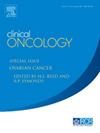乳腺癌放疗中区域淋巴结划分的可变性及其剂量学影响
IF 3.2
3区 医学
Q2 ONCOLOGY
引用次数: 0
摘要
目的利用FAST-Forward (FF)试验前放疗质量保证(QA)基准病例,量化乳腺癌放疗(RT)中区域淋巴结描绘的观察者间变异性,并确定轮廓变化与剂量测定之间是否存在关系。材料和方法作为试验前RT QA的一部分,要求当地主要研究者(pi)完成一个概述QA基准病例,涉及腋窝淋巴结临床靶体积(LNCTVs)水平1-4的描述。根据专家定义的共识金标准(GS)体积,使用各种一致性指数(CIs)评估这些轮廓的一致性:不一致性指数(DI)、地理缺失指数(GMI)、Jaccard指数(JCI)、轮廓过高和轮廓不足的平均一致性距离(MDC)。采用包括四分位间距(IQR)在内的描述性统计来评估观察者间的差异。使用Wilcoxon符号秩检验来确定符合GS体积的方案与来自个体PI的体积之间的剂量学参数是否存在统计学上的显著差异。结果对29/33个pi的审前QA基准病例进行了评估。提交nlctv的中位容积为131.4 cc (IQR: 112.4 - 145.3),而GS的中位容积为105.46 cc。对于一致性指标,中位DI为0.37 (IQR: 0.31 - 0.40),中位GMI为0.21 (IQR: 0.13 - 0.28),中位JCI为0.53 (IQR: 0.49 - 0.56), MDCunder为-0.43 (IQR: -0.64 -0.32), MDCover为0.46 (IQR: 0.43 - 0.53)。剂量学分析表明,所有计划都符合强制性计划剂量限制,但未达到试验方案所要求的目标体积的最佳目标。在符合个体PI容积和GS容积的方案中,有7/13个危险器官的剂量学参数存在统计学差异。结论:FF审前QA概述基准病例的分析突出了腋窝淋巴结CTV(1-4级)描述中存在的观察者间差异。整合指数与中位Jaccard整合指数(0.53)表现出适度的一致性,同时观察到轮廓不足和轮廓过度。所有提交的QA都达到了强制性计划剂量限制,但并非所有FF试验的最佳剂量目标,尽管目标体积轮廓在观察者之间存在差异。本文章由计算机程序翻译,如有差异,请以英文原文为准。
Regional Lymph Node Delineation variability and its Dosimetric Impact in Breast Cancer Radiotherapy
Aims
To quantify the interobserver variability of regional lymph node delineation for breast cancer radiotherapy (RT) and establish whether a relationship exists between contouring variations and dosimetry using the FAST-Forward (FF) pre-trial RT quality assurance (QA) benchmark cases.
Materials and methods
As part of the pre-trial RT QA, local site principal investigators (PIs) were asked to complete a single outlining QA benchmark case involving the delineation of axillary lymph node clinical target volumes (LNCTVs) levels 1–4. These contours were evaluated for concordance against an expert defined consensus gold standard (GS) volume using various conformity indices (CIs): discordance index (DI), geographical miss index (GMI), Jaccard index (JCI), mean distance to conformity (MDC) for both over- and under- contouring. Descriptive statistics including interquartile range (IQR) was used to evaluate interobserver variation. Wilcoxon signed-rank tests were used to establish if there were any statistically significant differences in the dosimetric parameters between plans conforming to GS volume and the volumes from the individual PI.
Results
Pre-trial outlining QA benchmark cases from 29/33 PIs were assessed. The median submitted LNCTV volume was 131.4 cc (IQR: 112.4 – 145.3) compared with the GS volume of 105.46 cc. For conformity indices, the median DI was 0.37 (IQR: 0.31 – 0.40), the median GMI was 0.21 (IQR: 0.13 – 0.28), the median JCI was 0.53 (IQR: 0.49 – 0.56), MDCunder was -0.43 (IQR: -0.64 - -0.32) and MDCover was 0.46 (IQR: 0.43 – 0.53). A dosimetric analysis showed all plans met the mandatory planning dose constraints but not the optimal objectives for target volumes as required in the trial protocol. Statistically significant differences were found in 7/13 organs at risk dosimetric parameters between plans conformed to individual PI volumes and the GS volume.
Conclusion
Analysis of the FF pre-trial QA outlining benchmark case highlights the interobserver variation that exists in axillary nodal CTV (levels 1–4) delineation. Conformity indices demonstrated moderate agreement with a median Jaccard conformity index of 0.53, with both under- and over-contouring observed. All QA submissions achieved the mandatory planning dose constraints but not all optimal dose objectives of the FF trial despite the interobserver variation in target volume contouring.
求助全文
通过发布文献求助,成功后即可免费获取论文全文。
去求助
来源期刊

Clinical oncology
医学-肿瘤学
CiteScore
5.20
自引率
8.80%
发文量
332
审稿时长
40 days
期刊介绍:
Clinical Oncology is an International cancer journal covering all aspects of the clinical management of cancer patients, reflecting a multidisciplinary approach to therapy. Papers, editorials and reviews are published on all types of malignant disease embracing, pathology, diagnosis and treatment, including radiotherapy, chemotherapy, surgery, combined modality treatment and palliative care. Research and review papers covering epidemiology, radiobiology, radiation physics, tumour biology, and immunology are also published, together with letters to the editor, case reports and book reviews.
 求助内容:
求助内容: 应助结果提醒方式:
应助结果提醒方式:


